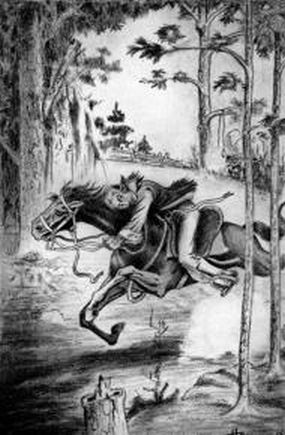Part i: Introduction; Part ii: Loyalists' Role in the War; Part iii: African American Loyalists; Part iv: Loyalist Fate at War's End; Part v: References
See also: Act of Pardon and Oblivion; Brown's Marsh, Battle of; Highland Regiment, North Carolina; Lindley's Mill, Battle of; Llewelyn Conspiracy; Moore's Creek Bridge, Battle of.

Historians have described North Carolina's treatment of Loyalists as "light." There were many trials and imprisonments, but large numbers of Loyalists were merely paroled to their neighborhoods. Serious offenders against the trend to independence, or those who continued to wage attacks in the state after the war had officially ended, had their property confiscated, but as often as not provision was made for wives and dependent children to continue in possession of adequate resources. Individuals who were potentially dangerous, however, were rounded up and transported out of North Carolina to an area that was more securely in American hands.
When Cornwallis went into Virginia, a number of North Carolinians, mainly militia, accompanied him. Some of them were captured after Yorktown, and they were exchanged for transport to the British post at New York and went from there to Nova Scotia. Similarly, other North Carolina Loyalists who happened to be with British forces at the time of their departure went with them to East Florida, England, Scotland, Ireland, British North America, the Bahamas, the West Indies, and the Mosquito Coast. Many of them returned to North Carolina; probably far more Loyalists remained in North Carolina than left it. On the other hand, in the early 1790s a few Loyalists moved from Rowan and Orange Counties to present-day Ontario, Canada.
In general, the perception and treatment of Loyalists in North Carolina depended on local relationships and circumstances. This was as true after the war as it was during the conflict. Wartime legislation gave authority to district commissioners to sell property owned by persons named in the Confiscation Acts. Later, those named in the acts were specifically excluded from the pardon that the 1783 Act of Pardon and Oblivion provided. The law also denied pardon to anyone who had held a British commission.
After the war, American Loyalists could have their claims concerning lost land, property, money, and salary reviewed by a special committee in England. A great many whose losses were only moderate probably made no effort to recoup anything. There were 243 people, however, who took the time and trouble to obtain the evidence necessary to support their claims. The majority of the claims were rejected, and the claimants who were paid received only about 10 percent of the value of their losses.
The final arbiter of property owned by Loyalists seems to have been the district and county courts. Particularly on the county level, persons accused of Loyalism stood to lose their property by debt suits and resulting sheriffs' sales unless they were protected by friends and family with local authority. Several wives petitioned the legislature for ownership of their departed husbands' property. A wife's ownership was not a protection against debt suits, however. On the other hand, some Loyalists returned to their home areas and resumed peaceful lives, and many never left their North Carolina homes.